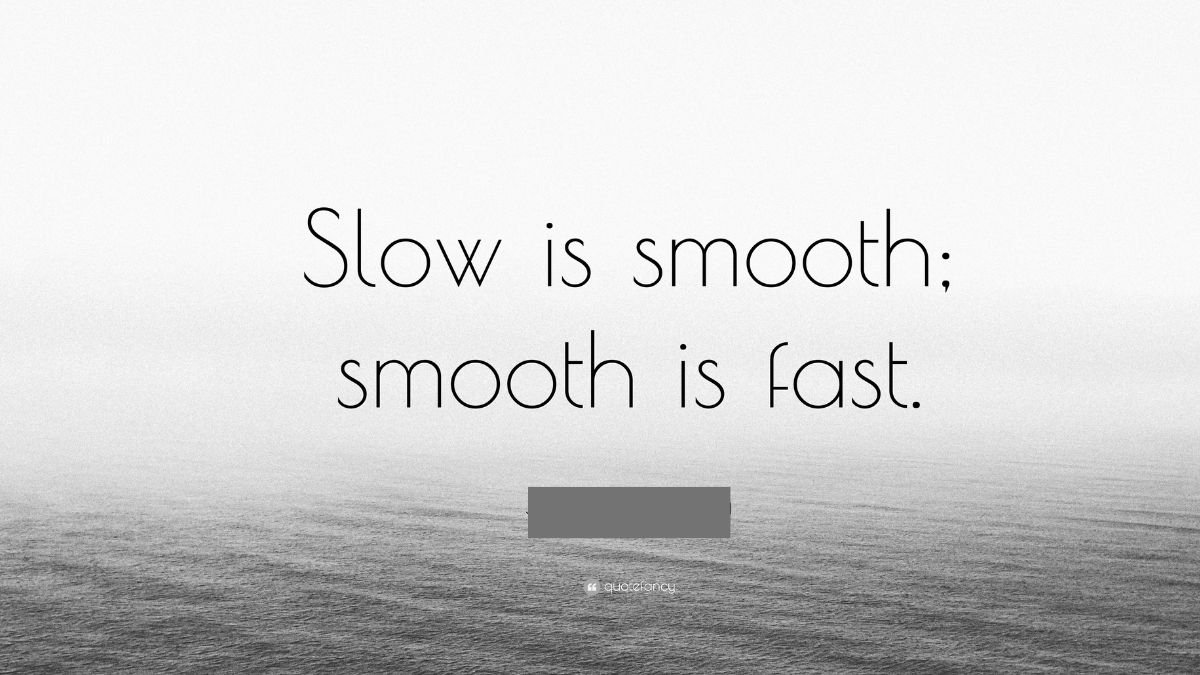In a world that values speed and efficiency above all else, it may seem counterintuitive to embrace the concept of “slow is smooth smooth is fast.” But what if I told you that by slowing down and approaching tasks with deliberate precision, you could actually become more productive? This age-old adage holds profound wisdom that can transform your productivity and help you achieve more in less time.
At first glance, the idea of working slowly may appear contradictory to our modern understanding of productivity. However, this concept goes beyond mere slowness; it emphasizes the importance of mindful execution in order to achieve optimal results. By focusing on being smooth and deliberate in our actions, we can ultimately increase our overall efficiency.
The origins of this phrase can be traced back to military tactics. It was often used in special forces training where soldiers were taught not to rush but instead carry out their missions meticulously. The belief behind it was that by taking things slow and ensuring each step was executed flawlessly (smoothly), they would finish their mission faster than if they had hurried through it.
Table of Contents
The Concept of “Slow is Smooth Smooth is Fast”
The concept of “Slow is Smooth Smooth is Fast” may seem counterintuitive at first. After all, we often equate speed with efficiency and productivity. However, this phrase encapsulates a deeper understanding of how working slowly can actually lead to greater effectiveness in the long run.
The idea behind “Slow is Smooth Smooth is Fast” emphasizes the importance of taking deliberate and calculated steps in order to achieve optimal results. By slowing down our pace and focusing on each task or action with precision, we are able to reduce mistakes and minimize wasted efforts. This approach allows us to work smoothly without disruptions or setbacks, ultimately leading to faster progress towards our goals.
In essence, it’s about being intentional and mindful in our actions rather than rushing through tasks mindlessly. Taking the time to plan out our approach and execute each step carefully helps us maintain better control over the process. It enables us to identify potential roadblocks early on and find efficient solutions before they become major obstacles.
By embracing the philosophy of “Slow is Smooth Smooth is Fast,” we can transform our productivity by prioritizing quality over quantity. It encourages us to work diligently instead of frantically chasing deadlines or trying to multitask excessively. So remember: sometimes working slower can actually make you faster in achieving your desired outcomes!
Exploring the Meaning and Origins
The concept of “Slow is Smooth Smooth is Fast” may sound counterintuitive at first, but it holds profound wisdom when applied to productivity. Exploring its meaning and origins can shed light on how this principle can transform our approach to work.
The phrase itself has military origins, often used in special forces training as a reminder to remain calm and deliberate in high-pressure situations. It emphasizes the importance of taking things slow and steady, focusing on smooth execution rather than rushing through tasks haphazardly. This allows us to maintain clarity of thought and make better decisions under pressure.
By understanding the meaning and origins of “Slow is Smooth Smooth is Fast,” we gain insight into why working slowly can actually lead to greater efficiency. It encourages us to prioritize quality over speed, ensuring that each task or project receives the attention it deserves. This deliberate approach helps minimize errors or rework down the line, ultimately saving time in the long run.
The Importance of Working Slow
When it comes to productivity, the idea of “slow is smooth smooth is fast” holds a significant meaning. Many people believe that working faster automatically equates to being more productive. However, taking the time to work slowly and deliberately can actually lead to greater efficiency in the long run.
Working slow allows us to focus on quality rather than rushing through tasks just to get them done. By giving ourselves ample time for each task, we can pay attention to details, reduce errors, and ensure that our work meets or exceeds expectations.
Moreover, working slowly also promotes better decision-making. When we rush through tasks or make hasty decisions without careful consideration and analysis, we are more likely to overlook important factors or make mistakes. Taking the time to think things through and approach tasks with patience enables us to make informed choices that are more likely to yield positive outcomes.
By embracing a slower pace of work, we create space for reflection and creativity as well. It allows us room for innovative ideas and alternative solutions by not getting caught up in the chaos of constant busyness.
In today’s fast-paced world where speed seems valued above all else, it may feel counterintuitive at first glance. However, slowing down can truly transform our productivity by allowing us the opportunity for thoroughness and thoughtfulness in everything we do.
Applying the Principle to Productivity
One area where the concept of “slow is smooth smooth is fast” can have a profound impact is in our productivity. By taking a deliberate and measured approach to our work, we can actually achieve more in less time.
When it comes to productivity, incorporating agile principles into our workflow can be incredibly helpful. Agile focuses on breaking tasks down into manageable chunks and prioritizing them based on their importance and urgency. By working slowly through each task with careful attention to detail, we ensure that we are completing them effectively and efficiently.
Another aspect of applying this principle to productivity involves effective communication with clients or leadership. It’s important to clearly communicate our capacity for taking on new projects or responsibilities so that we don’t overload ourselves and compromise the quality of our work. Setting realistic expectations from the start allows us to maintain a steady pace without sacrificing efficiency.
By embracing the philosophy of “slow is smooth smooth is fast,” we can revolutionize how we approach productivity. Taking intentional steps towards mastering efficiency will not only enhance our output but also reduce stress levels and improve overall job satisfaction.
Agile Principles and Working Slow
Agile principles and working slow may seem like contradictory concepts, but they can actually go hand in hand to boost productivity. Agile methodologies emphasize adaptability, collaboration, and continuous improvement. By taking the time to work slowly and deliberately, you can ensure that each step of a project is completed with care and attention to detail.
When applying agile principles to your work, it’s important to prioritize tasks based on their value and impact. This means focusing on high-priority items first while still allowing time for reflection and refinement. Working slowly allows for better communication between team members, fostering collaboration and ensuring that everyone is aligned on goals and expectations.
Agile principles encourage a deliberate approach to working slow which enables teams to achieve greater efficiency by prioritizing tasks effectively and facilitating effective communication among team members.
Communicating Capacity with Clients or Leadership
When it comes to productivity, being able to effectively communicate your capacity is crucial. It allows you to manage expectations and ensure that everyone involved understands what you can realistically deliver within a given timeframe.
One way to do this is by setting clear boundaries and deadlines from the start. By clearly defining the scope of work and providing realistic timelines, you can help clients or leadership understand the amount of time needed for each task. This helps prevent overloading yourself with unrealistic demands and ensures that quality work can be produced without unnecessary stress.
Additionally, regularly updating clients or leadership on your progress is essential. By providing regular status updates, you keep them informed about how things are progressing and any potential roadblocks or delays that may arise. This open communication fosters trust and transparency in your working relationship while also allowing them to make necessary adjustments if needed.
Effectively communicating your capacity not only helps manage expectations but also shows professionalism in keeping stakeholders informed throughout the process. Making sure there is clarity regarding timelines and progress ensures a smoother workflow for everyone involved, ultimately leading to increased productivity in achieving desired goals.
Mastering Efficiency in Daily Life
In our fast-paced world, it can be challenging to master efficiency in daily life. However, by embracing the principle of “slow is smooth smooth is fast,” you can transform your productivity. One key strategy is prioritizing tasks and breaking them down into manageable chunks. By focusing on one task at a time, you’ll avoid overwhelm and increase your chances of completing each task efficiently.
Another effective strategy is utilizing time-blocking techniques. Set aside specific blocks of time for different activities or projects throughout the day. This allows you to dedicate uninterrupted focus to each task, eliminating distractions and maximizing productivity. Additionally, incorporating regular breaks into your schedule ensures that you maintain mental clarity and prevent burnout.
While striving for efficiency in daily life, challenges may arise that hinder your progress. Procrastination is a common obstacle that can derail productivity efforts. To overcome this challenge, try using the Pomodoro Technique – work intensely for short bursts followed by brief breaks – as it helps combat procrastination while maintaining energy levels.
Another obstacle could be multitasking tendencies; however, research shows that attempting multiple tasks simultaneously leads to decreased performance quality. Instead of succumbing to the allure of multitasking, prioritize single-tasking to enhance focus and achieve better results.
By implementing these strategies and overcoming obstacles along the way, you will gradually master efficiency in daily life without sacrificing quality or burning out unnecessarily.
Strategies for Working Slow and Achieving More
In today’s fast-paced world, it may seem counterintuitive to work slow in order to achieve more. However, the concept of “slow is smooth smooth is fast” reminds us that taking our time and approaching tasks with deliberate focus can actually lead to increased productivity. Here are some strategies for working slow and achieving more:
Prioritize your tasks. By identifying what needs to be done first and breaking larger projects into smaller manageable steps, you can avoid feeling overwhelmed and stay focused on one task at a time.
Practice mindfulness while working. This means being fully present in the moment and giving your full attention to the task at hand. Minimize distractions by turning off notifications or finding a quiet space where you can concentrate without interruptions.
Remember, efficiency doesn’t always mean rushing through tasks; it means using your time wisely and effectively. By implementing these strategies for working slow and maintaining a steady pace throughout your day, you’ll find yourself accomplishing more with less stress. So embrace the power of “slow is smooth smooth is fast” and watch as your productivity soars!
Overcoming Challenges and Obstacles
In the pursuit of mastering efficiency, there will inevitably be challenges and obstacles along the way. However, with the principle of “slow is smooth, smooth is fast” as your guiding mantra, you can navigate through these hurdles effectively.
One common challenge is dealing with distractions. In today’s fast-paced world filled with constant notifications and interruptions, staying focused can be difficult. To overcome this obstacle, try setting specific time blocks for uninterrupted work or using productivity tools to minimize distractions. Additionally, practicing mindfulness techniques like deep breathing or meditation can help center your mind and improve concentration.
Another obstacle to tackle is procrastination. We often find ourselves putting off important tasks until the last minute due to various reasons such as fear of failure or lack of motivation. To combat procrastination, break down tasks into smaller manageable chunks and create a schedule that allows for regular breaks. Celebrate small wins along the way to maintain momentum and keep yourself motivated.
By acknowledging these challenges and proactively finding ways to overcome them within the framework of “slow is smooth, smooth is fast,” you’ll steadily improve your productivity levels and achieve more in both personal and professional realms.
Conclusion
Mastering the Art of Efficiency: How “Slow is Smooth Smooth is Fast” Can Transform Your Productivity
In a fast-paced world filled with constant demands and expectations, it’s easy to get caught up in the chaos. However, by embracing the concept of “slow is smooth smooth is fast,” you can transform your productivity and achieve remarkable results.
The meaning behind this phrase goes beyond its surface level interpretation. It encourages us to take a deliberate approach to our work, focusing on quality over quantity and allowing ourselves the time we need to fully understand and execute tasks.
By working slow, we give ourselves the space to think critically and make well-informed decisions. This approach aligns perfectly with Agile principles, allowing for adaptability and continuous improvement.
Additionally, communicating our capacity effectively with clients or leadership ensures that we can deliver high-quality work without compromising on timelines or burning out. Setting realistic expectations upfront fosters trust and collaboration while ensuring everyone involved understands what can be achieved within a given timeframe.
When it comes to mastering efficiency in daily life, strategies such as prioritizing tasks based on importance and urgency, breaking them down into smaller manageable chunks, utilizing tools like time blocking or Pomodoro Technique for focused bursts of productivity—all contribute to working slow but achieving more.
Of course, there will always be challenges along the way—distractions that tempt us away from our focus or unexpected obstacles that require quick thinking—but by staying committed to the principle of “slow is smooth,” we develop resilience in overcoming these hurdles while maintaining our productivity levels.





